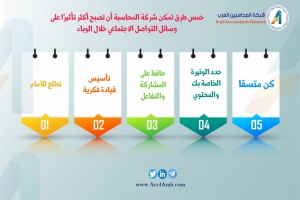عرض العناصر حسب علامة : Instagram
الخميس, 23 سبتمبر 2021 21:59
أدوات لتحسين تدريسك هذا الفصل الدراسي
معلومات إضافية
-
المحتوى بالإنجليزية
June 8, 2021
6 ways to include more technology in the accounting curriculum
March 9, 2021
Get started with robotic process automation
TOPICS
Accounting Education
Accounting faculty are always looking for new technologies that will engage their students. During this year’s AAA Conference for Teaching and Learning, faculty shared a number of apps, games, social media platforms, and other tools that worked well for them in the classroom. Many of these apps are free or low cost, work across many types of devices, and are appropriate for both remote and in-person classrooms. Here are just a few to try:
Set your class on ‘fire’ with gamification
If participation on your class’s online discussion boards is lackluster, you may want to look into ClassCred. Chris Edmonds, Ph.D., associate professor of accounting and finance at the University of Alabama at Birmingham, has had great success with ClassCred, an extension of Slack that allows students and instructors to give “fire” points to discussion comments they find most valuable. Students can earn digital badges for different accomplishments, such as posting a certain number of times or receiving a certain amount of fire. Individuals or the class can also earn rewards, set by the instructor, when they reach a certain level of fire. For example, students can try for a review session, an outdoor class, a pizza party, or lunch paid for by the instructor.
Faculty can start a leaderboard where students can see who has gotten the most fire, which really brings out a competitive streak in students, Edmonds said. The top student receives the GOAT (greatest of all time) Badge; that student is one you want to tap as your future TA, he joked.
ClassCred also has a “back-end tool” that enables instructors to get an overview of a class’s discussion, so they don’t have to read every post, Edmonds said. Students can tag instructors in a post if they have a question, and their classmates can also answer questions.
Slack does have a bit of a learning curve, Edmonds said, but once students get accustomed to it, it comes easily to them. Slack is available in free and low-cost versions, and educators can receive a discount on the paid versions. ClassCred costs $1 per user per month but is free to most educators.
Encourage students to give more robust feedback
Faculty often have students complete projects in groups as a means of teaching them soft skills such as collaborating and giving feedback. Students, however, sometimes struggle with group work or fail to take it seriously. The CATME program, developed by Purdue University, is one tool that can help. Students log on to CATME to rate their own and their groupmates’ performance. The program includes a rubric they can use and sample evaluations they can take prior to doing so, which prompts them to give more thoughtful feedback.
CATME then presents the data from the evaluations in a format faculty can use to assess students’ group dynamics, said Christopher Cook, CPA, CGMA, senior lecturer of accounting at Indiana University Bloomington, who uses the program in his master’s-level courses. You can see when students are over- or under-rating themselves, or when groups have split up into factions, he said, and you can then intervene if necessary.
CATME and the evaluation process help develop soft skills that students will need in the workplace, he said. “At some point in their career, they will be evaluated on how the people they manage perform,” so they need to be able to give useful feedback, he said in an interview. “We want to give students as close to a real-world perspective as we can.”
Faculty can also use CATME to divide students into groups based on criteria they specify. For example, they can use it to ensure groups are equally distributed by gender or to put students with similar interests (sports, Greek life, etc.) in the same or different groups, depending on your goals. (Cook doesn’t use this function because, due to the structure of his master’s program, students are already in preset groups.)
CATME charges an annual licensing fee based on the number of students who use it, and Purdue is testing an option for students to pay for it as part of their course materials. The average cost per student is $2.96.
Meet students on the social media platform they love
After seeing how much her college-age children enjoyed TikTok, Monique Kelley, CPA, an accounting faculty member at Fresno City College in Fresno, Calif., decided to give the social media platform a try in her accounting classes. TikTok allows viewers to post and respond to videos of no more than one minute in length. It’s extraordinarily popular with Gen Zers, who make up 60% of its users.
Kelley posts weekly video announcements on TikTok, which include encouragement if she senses students are struggling. She also makes short instructional videos on the platform, and uses it to reach out to students before the semester starts to get them excited about her class. She has received positive feedback from students, and said that using TikTok makes accounting seem more approachable to them.
As TikTok videos are so brief, Kelley said, they take relatively little time to record. She usually records the videos first and adds voiceovers and transcriptions — both of which are optional — later. She has separate TikTok accounts for teaching and personal use, she said, and noted that you can automatically upload TikTok videos to Instagram or Twitter if you use those platforms. TikTok is free to use.
Let remote students collaborate in real time
The app GroupMe can be a good option for faculty who are looking for a self-contained way to send and receive messages from students. Cori Crews, CPA, DBA, assistant professor of accounting at Valdosta University in Valdosta, Ga., who presented on myriad ways to improve collaboration among remote students, uses it in her classes. GroupMe sets up what is basically a private chat room that only you and your students can access. Users can share photos and videos, use emoji, and “like” messages. The app is free and works on all devices and over SMS text messaging.
Crews has also successfully used the Jamboard mobile app, a Google app that functions like a digital whiteboard, in her classes. On Jamboard, you can “write” and “erase” as you would on a regular whiteboard, making it a good way to share handwritten formulas and demonstrate calculations, Crews said.
Students can also use Jamboard to make presentations in video meetings, and to collaborate with classmates. They can add Google Documents, Sheets, and Slides, as well as images and videos, to their “boards,” which they can invite groupmates to join and edit. The software saves changes automatically, and it works on mobile devices as well as desktops. Jamboard is available as a free app or as a function on Google Workspace.
نشر في
موضوعات متنوعة
الإثنين, 23 مايو 2022 14:44
إنفوجرافيك.. كيف يمكن للمحاسبين تحقيق النمو عبر وسائل التواصل الاجتماعي؟!
نشر في
إنفوجرافيك
الخميس, 11 يونيو 2020 13:07
كيف يمكن للمحاسبين تحقيق النمو عبر وسائل التواصل الاجتماعي؟!
نظرًا لأن معظم العالم يعزل نفسه الان، فقد زودت وسائل التواصل الاجتماعي المستهلكين بالاتصال خارج محيطهم المباشر، مما ساعد في الحفاظ على العلاقات عبر الإنترنت.
نشر في
تكنولوجيا المعلومات



